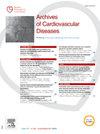磷酸肌肽3-激酶(PI3K)调节窦房结“起搏器”l型Cav1.3通道是年龄相关性窦房结功能障碍和心动过缓的机制
IF 2.2
3区 医学
Q2 CARDIAC & CARDIOVASCULAR SYSTEMS
引用次数: 0
摘要
窦房结功能障碍(SND)是由于窦房结动作电位不能正常产生而引起的。SND患者临床诊断为窦性心动过缓,一般定义为心率低于50bpm。最常见的SND形式与心脏组织的老化有关。目前只有少数药物可用于治疗短暂性SND。然而,大多数患者表现为慢性症状性SND,只能通过起搏器植入作为最终治疗。在欧洲和美国,SND现在每年有近50万起搏器植入,预计这一数字将在未来半个世纪翻一番。考虑到SND的全球负担,需要基于对疾病机制的新见解的创新药理学和分子策略来治疗SND。最近,研究表明,“滑稽”电流(If)和心率是由磷酸肌肽3-激酶(pi3k)通过一种独立于自主神经系统输入的机制积极调节的。虽然已知心率、SN离子通道的表达和pi3k活性都随着年龄的增长而下降,但pi3k在年龄相关性SN型心动过缓中的作用尚不清楚。目的探讨年龄相关性SND中哪些SN离子电流受pi3k调控,重点研究Cav1.3和cav1.2介导的l型Ca2+电流(ICaL)的区别。方法采用幼年(2月龄)和老年(24月龄)小鼠分离SN细胞。1 μM Calciseptine (Cas)是一种选择性Cav1.2通道阻滞剂,用于区分pi3k对Cav1.3和Cav1.2亚型的调节。灌注Cas时,Cas敏感电流归属于Cav1.2,而抗性部分归属于Cav1.3。用1 μM PI-103培养SN细胞2 h,抑制pi3k后进行补片实验。结果检测了PI-103对老年小鼠SN肌细胞If的影响。PI-103在电流密度和激活曲线位移方面对If没有影响。衰老对老年小鼠ICav1.2没有影响,但ICav1.3降低。PI-103仅降低幼鼠ICav1.3振幅,不改变ICav1.2。PI-103对老龄小鼠Cav1.3和cav1.2介导的l型Ca2+电流均无影响。结论PI3K对Cav1.3和Cav1.2通道的调控为成人和老年SN中PI3K和l型Ca2+通道调控SN内在速率的离子机制提供了新的认识。本文章由计算机程序翻译,如有差异,请以英文原文为准。
Regulation of sinus node “pacemaker” L-type Cav1.3 channels by phosphoinositide 3-kinase (PI3K) as a mechanism underlying age-related sinus node dysfunction and bradycardia
Introduction
Sinus node (SN) dysfunction (SND) is caused by failure to generate a normal SN action potential. SND patients are identified clinically as having sinus bradycardia, generally defined as a heart rate below 50 bpm. The commonest form of SND is related to ageing of the cardiac tissue. Only a few pharmacologic options are currently available to treat transient SND. However, most patients present with chronic symptomatic SND that can be treated only by pacemaker implantation as definitive therapy. In Europe and the U.S., SND now accounts for nearly half a million-pacemaker device implantations per year and this is predicted to double over the next half century. Considering this global burden of SND, innovative pharmacologic and molecular strategies based on novel insights into disease mechanisms are needed for SND treatment. Recently, it has been demonstrated that the ‘funny’-current (If) and heart rate are positively regulated by phosphoinositide 3-kinase (PI3 K), by a mechanism which is independent of the autonomic nervous system input. Although it is known that heart rate, expression of SN ion channels and PI3 K activity all decrease with age, the role of PI3 K in age-related SN bradycardia remains unexplored.
Objective
To determine which SN ionic currents are regulated by PI3 K in age-related SND focusing on the discrimination between Cav1.3 and Cav1.2–mediated L-type Ca2+ currents (ICaL).
Method
WT young (2 months old) and aged (24 months old) mice were used to isolate SN cells. 1 μM Calciseptine (Cas) – a selective Cav1.2 channel blocker – was used to distinguish between regulation by PI3 K of Cav1.3 and Cav1.2 isoform. Upon perfusion of Cas, the Cas-sensitive current is attributed to Cav1.2, while the resistant component is attributed to Cav1.3. SN cells were incubated for 2 h with 1 μM PI-103 to inhibit PI3 K before patch experiments.
Results
We tested the effect of PI-103 on If in SN myocytes from aged mice. PI-103 had no effect on If in terms of current density and shift in activation curve. Aging had no effect on ICav1.2 but ICav1.3 was reduced in old mice. PI-103 reduced only ICav1.3 amplitude without changing ICav1.2 in young mice. PI-103 had no effects on both Cav1.3 and Cav1.2–mediated L-type Ca2+ currents in old mice.
Conclusion
Dissection of PI3 K regulation of Cav1.3 and Cav1.2 channels provides new knowledge on the ionic mechanisms of regulation of intrinsic SN rate by PI3K and L-type Ca2+ channels in adult and aged SN.
求助全文
通过发布文献求助,成功后即可免费获取论文全文。
去求助
来源期刊

Archives of Cardiovascular Diseases
医学-心血管系统
CiteScore
4.40
自引率
6.70%
发文量
87
审稿时长
34 days
期刊介绍:
The Journal publishes original peer-reviewed clinical and research articles, epidemiological studies, new methodological clinical approaches, review articles and editorials. Topics covered include coronary artery and valve diseases, interventional and pediatric cardiology, cardiovascular surgery, cardiomyopathy and heart failure, arrhythmias and stimulation, cardiovascular imaging, vascular medicine and hypertension, epidemiology and risk factors, and large multicenter studies. Archives of Cardiovascular Diseases also publishes abstracts of papers presented at the annual sessions of the Journées Européennes de la Société Française de Cardiologie and the guidelines edited by the French Society of Cardiology.
 求助内容:
求助内容: 应助结果提醒方式:
应助结果提醒方式:


